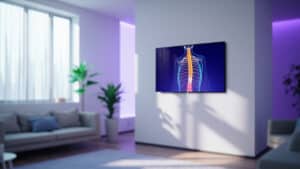Written by Dr. Matthias Wiederholz, MD, Quadruple Board-Certified in Pain Medicine, PM&R, Sports & Regenerative Medicine
Quick Insights
Cervical radiculopathy is a pinched nerve in the neck, caused by pressure on nerve roots. This can lead to sudden pain, numbness, or weakness down the arm. Immediate expert evaluation is essential to prevent long-term nerve injury and improve outcomes.[1](https://www.dovepress.com/manual-therapy-for-cervical-radiculopathy-effects-on-neck-disability-a-peer-reviewed-fulltext-article-JPR).
Key Takeaways
- Most patients feel sharp, radiating pain from the neck to the hand when nerves are compressed.
- Degenerative disc disease and herniated discs are frequently behind nerve root compression at C5-C6.
- Research shows that many people avoid surgery with advanced non-surgical treatments.
- Early specialist care lessens the risk of permanent weakness or activity loss.
Why It Matters
Cervical radiculopathy can rob you of movement, disrupt work, and limit your favorite activities. Understanding your options means you can act quickly, reduce anxiety about surgery, and take back control over your quality of life—starting today.
As a quadruple board-certified spine specialist and Houston radiculopathy specialist, I’ve helped thousands in Houston finally get answers for cervical radiculopathy. If you’re searching for expert care, you can learn more about my background as Dr. Matthias Wiederholz, MD.
Cervical radiculopathy is a pinched nerve in the neck—usually from nerve root compression at C5-C6—that causes sharp, radiating arm pain, numbness, or weakness. This condition can disrupt daily activities, steal sleep, and leave you fearful about your future mobility if left unaddressed. Early, precise intervention is critical to prevent long-term loss of function and restore your quality of life.
For patients with chronic disc issues who have not found relief with conservative care, advancing to minimally invasive spine procedures like Discseel® can be a game changer.
Research highlights that advanced manual therapy and targeted rehabilitation significantly improve outcomes for patients with cervical radiculopathy, frequently helping them avoid invasive surgery.
If radiating arm pain or neck tingling is interfering with your active life, it’s time to explore the innovative, minimally invasive solutions available right here in Houston.
What is Cervical Radiculopathy?
Cervical radiculopathy is a clinical syndrome where a nerve root in your neck becomes compressed or irritated, often at the C5-C6 level. This “pinched nerve in neck” can cause pain, numbness, or weakness that radiates from your neck down your arm. I see this most often in patients who suddenly notice shooting pain after a minor movement or wake up with tingling in their hand.
If you’d like to understand similar conditions like herniated disc symptoms and treatments, knowledge is key to rapid recovery.
Understanding Nerve Root Compression C5-C6
The C5-C6 region is a common site for nerve root compression because it bears much of the neck’s movement and stress. When a disc herniates or degenerates here, it can press on the nerve root, triggering symptoms down the arm. As a quadruple board-certified specialist, I’ve observed that early identification of C5-C6 involvement is important for timely intervention, which may improve outcomes.
Current clinical trials are directly comparing surgical and non-surgical approaches to managing this condition, highlighting the importance of accurate diagnosis and tailored treatment.
If you’d like to learn more about symptoms of bulging discs at C5-C6, visit our in-depth resource.

Symptoms and Signs of a Pinched Nerve in the Neck
The hallmark of cervical radiculopathy is radiating arm pain from the neck, often described as sharp, burning, or electric. You might also notice numbness, tingling, or muscle weakness in your shoulder, arm, or hand. These symptoms can make it difficult to grip objects, type, or even sleep comfortably.
In my practice, I frequently see patients who mistake their symptoms for simple muscle strain or believe pain is normal as they age, when in fact these classic nerve signals often point to something more serious beneath the surface.
Radiating Arm Pain From Neck: Warning Signs
- Sudden, shooting pain from the neck to the hand
- Pain worsens with certain neck movements
- Discomfort that disrupts daily activities
Expert sources explain that these symptoms result from nerve inflammation and compression.
If you’re also dealing with cervical herniated disc symptoms, proper assessment is vital.
Numbness and Weakness Explained
Numbness or weakness often means the nerve is more severely affected. I always advise patients to seek prompt evaluation if they notice dropping objects or difficulty lifting the arm, as this may indicate issues with nerve function.
Having personally treated thousands with these symptoms, I’ve found that acting early—before weakness becomes constant—often leads to dramatically better outcomes and helps patients avoid the pitfalls of irreversible nerve change.
When to Seek Medical Attention
If you experience sudden arm weakness, loss of bladder or bowel control, or severe, unrelenting pain, contact a physician immediately. These may indicate a serious nerve injury requiring urgent care.
Causes and Risk Factors
Cervical radiculopathy is most often caused by degenerative disc disease, herniated cervical discs, or bone spurs that narrow the space where nerves exit the spine. In my experience, repetitive neck movements, poor posture, and previous neck injuries may increase the risk of neck problems.
- Common causes:
- Degenerative disc changes (Learn about degenerative disc disease treatment options)
- Herniated cervical disc (Read about ruptured disc treatments)
- Bone spurs (osteophytes)
- Risk factors:
- Age over 40
- Physically demanding work
- Smoking
Often, patients are surprised to learn that many triggers—such as years at a desk with poor ergonomics or old sports injuries—are within their control. By identifying these risk factors, we can not only treat your current pain but also help you prevent future flare-ups.
Understanding these factors helps me tailor prevention and treatment strategies for each patient.

How is Cervical Radiculopathy Diagnosed?
Diagnosis starts with a detailed history and physical exam. I look for specific patterns of pain, numbness, and weakness that match nerve root involvement. Imaging studies, such as MRI or CT scans, confirm the diagnosis and pinpoint the exact site of nerve compression.
Electrodiagnostic tests may be used if symptoms are unclear or if multiple nerves could be involved. According to recent clinical trial protocols, accurate diagnosis is essential for selecting the most effective treatment and avoiding unnecessary surgery.
Unlike larger clinics where a patient might only see their physician for a brief moment, I personally guide each patient through the entire diagnostic process—from listening carefully to your concerns to interpreting your imaging myself. This hands-on approach, I believe, makes all the difference in tailoring the best plan for your recovery.
Explore more about the guide to spinal disc tears: causes and treatment options.

Non-Surgical Treatments for Cervical Radiculopathy
Most patients improve without surgery. I focus on non-surgical cervical radiculopathy treatment options that relieve pain, restore function, and help you return to activity quickly.
- Physical therapy: Exercises to improve neck strength and flexibility
- Manual therapy: Hands-on techniques to reduce nerve pressure
- Medications: Anti-inflammatories for pain and swelling
- Targeted injections: To calm nerve inflammation
Physical therapy has been shown in systematic reviews to improve range of motion and reduce pain—especially when combined with personalized guidance and consistent follow-up.
As a regenerative spine specialist, I’ve seen that combining physical and manual therapies with advanced treatments may accelerate healing and help patients avoid surgery. Whenever possible, I use movement-based and regenerative techniques to help restore natural function rather than just masking pain.
If you’re interested in exercises, try our herniated disc exercise guide for practical tips.
Physical Therapy and Manual Therapy Backed by Research
Manual therapy and traction are supported by systematic reviews as effective treatments for cervical radiculopathy. I often combine these with personalized exercise programs for optimal results, recognizing that every patient heals at their own pace.
A clinical observation from my Houston practice: patients who engage early in a targeted rehabilitation plan—especially when paired with education on ergonomics and posture—consistently achieve more rapid and lasting improvements than those relying on medications alone.
Emerging research also supports rehabilitation programs that include both physical and pharmacologic therapies, showing promise for even complex or long-standing cases.
If you need more insight into disc tear treatment for restoring spinal integrity, check our detailed treatment overview.
Discseel® vs. Spinal Fusion: Key Differences
Discseel® is a minimally invasive, non-surgical procedure that uses a biologic fibrin sealant to repair damaged discs and stop the inflammatory cascade. Unlike spinal fusion, which removes motion and requires hardware, Discseel® preserves your natural movement and involves no incisions. In my experience, patients recover faster and avoid the risks of major surgery.
As a Master Instructor personally trained by Discseel®’s inventor, Dr. Kevin Pauza, I can affirm that matching innovative technology to the right patient yields superior results. I’ve helped many avoid fusion entirely—even those told that surgery was their only option.
Learn more from Discseel® reviews and lasting back pain relief.

The Discseel® Procedure: Innovative Relief in Houston
Discseel® is a revolutionary treatment for cervical radiculopathy that I perform right here in my Houston office. By sealing the annulus fibrosis—the tough outer part of the disc—with a biologic fibrin sealant, I can stop inflammation and promote natural healing. This approach targets the root cause of pain, not just the symptoms.
Having personally performed over 10,000 regenerative spine procedures, I’ve consistently witnessed that truly restoring function and alleviating chronic pain involves not just clinical excellence, but a deep emotional and functional understanding of each patient’s needs. My Discseel® patients often express gratitude for regaining mobility without the downtime or disruption they once feared.
Research shows that cervical rotation-traction manipulation is both effective and safe for reducing pain in patients with nerve root compression. While Discseel® is unique, I integrate similar principles of restoring disc integrity and function.
Most patients return to daily activities within days, with no need for general anesthesia or hospital stays. As a Master Instructor for Discseel®, I have observed that this procedure may restore spinal function and improve quality of life, even for patients previously advised that surgery was their only option.
For more on advanced care, see how we manage pain for l4-l5 and l5-s1 discs.
Why Trust Dr. Matthias Wiederholz as Your Houston Radiculopathy Specialist?
As a quadruple board-certified specialist, I bring advanced training and national recognition to every patient encounter. My direct mentorship under Dr. Kevin Pauza, the inventor of Discseel®, ensures you receive the most up-to-date, evidence-based care.
Quadruple Board-Certified Expertise
My expertise spans Physical Medicine & Rehabilitation, Pain Medicine, Sports Medicine, and Regenerative Medicine. Over my career, I have performed thousands of minimally invasive spine procedures—each one with the goal of helping patients rediscover confidence in their bodies and hope for their futures.
As a physician deeply committed to patient-centered care, I emphasize thorough education, shared decision-making, and holistic strategies tailored to your lifestyle. My goal is always lasting results and restored quality of life, not just a quick fix.
Curious about how our approach compares for a Lawrenceville radiculopathy specialist? Learn more about services at all our locations.
The Concierge Patient Experience
At our Houston and Lawrenceville practices, we strive to provide personalized attention from the initial consultation through every stage of recovery. I tailor each treatment plan to your goals, whether you want to return to sports, work, or simply enjoy life without pain.
Unlike larger clinics where patients may rarely see the same provider, I personally oversee every aspect of your care—from detailed diagnostics to recovery and rehabilitation—so you feel truly understood, supported, and empowered.

What Our Patients Say on Google
Patient experiences are at the heart of my approach to treating cervical radiculopathy. Hearing directly from those who have undergone advanced procedures like Discseel® provides valuable insight for anyone considering their options.
I recently received feedback that captures what we aim to provide for every patient seeking relief from chronic pain:
“I recently underwent a Discseel procedure with Dr. Wiederholz, and I can’t express how grateful I am for the incredible relief it has provided. Chronic pain that had plagued my back and radiated down my leg has significantly subsided, and I am on the path to recovery with the assistance of Physical Therapy. While the healing process may take some time, I’ve learned that patience is key, as pushing too hard can be a challenge for me. I recommend anyone with herniated disc to do your research and consider the Discseel option.” — Chelsea
You can see more patient experiences on Google.
Stories like Chelsea’s remind me why it’s so important to offer innovative, non-surgical solutions for cervical radiculopathy—helping patients in Houston reclaim their lives and mobility.
Cervical Radiculopathy Care in Houston, TX
Living in Houston means facing unique challenges, from long commutes to active lifestyles that can put extra strain on the neck and spine. I see many patients whose symptoms of cervical radiculopathy are influenced by daily routines, whether it’s hours at a desk or time spent in Houston’s vibrant sports and recreation scene.
Access to advanced, non-surgical cervical radiculopathy treatment is essential in a city as dynamic as Houston. At Performance Pain and Sports Medicine, I provide personalized care that addresses both the root cause of your pain and the demands of your lifestyle. My approach combines the latest research-backed therapies with a deep understanding of what it takes to stay active in our community. See our Houston location for more information about treatment options near you.
If you’re in Houston and struggling with radiating arm pain, numbness, or weakness, know that expert help is available close to home. Schedule a consultation to see if you are a candidate for the Discseel® Procedure and take the first step toward lasting relief.
Frequently Asked Questions About Cervical Radiculopathy
Can cervical radiculopathy heal without surgery?
Yes, most patients recover with non-surgical care such as physical therapy, manual therapy, medications, or targeted injections. Recent randomized trials are directly comparing surgical and non-surgical treatments for cervical radiculopathy, showing that conservative approaches can be very effective—especially when started early.
How effective is the Discseel® Procedure for neck pain?
While long-term outcomes continue to be studied, my clinical results with Discseel® in carefully selected patients have been excellent, and systematic research highlights the value of restoring disc integrity. For some, it offers relief when traditional treatments and even surgery have failed.
Are non-surgical treatments proven to work?
Absolutely. Systematic reviews and randomized studies have confirmed that manual and physical therapy are effective for most patients, and minimally invasive traction therapies provide significant pain reduction with low risk.
What if I have had previous neck surgery or fusion?
Many of my patients seek care after spinal fusion or failed surgery. Innovative regenerative procedures, such as Discseel® or supervised rehabilitation, often provide meaningful improvement. Emerging rehabilitation protocols combining physical and pharmacological therapies are showing promise even in complex cases.
When should I see a specialist?
See a spine specialist promptly if you have arm or hand weakness, constant numbness, unrelenting pain, or if symptoms interfere with daily life. Early intervention, as demonstrated in recent systematic reviews, leads to higher rates of full recovery and fewer complications.
Conclusion
Cervical radiculopathy can disrupt every aspect of your life, but you don’t have to accept chronic pain or limited movement as your new normal. As a quadruple board-certified pain specialist, I’ve seen firsthand how advanced regenerative care—without invasive surgery—can help patients in Houston regain strength, comfort, and confidence. Most people recover without surgery, and innovative options like Discseel® offer real hope for lasting relief and restored mobility.
If radiating arm pain or a pinched nerve in your neck is keeping you from the activities you love, I encourage you to take action now. Early intervention leads to better outcomes and helps you avoid unnecessary surgery, as supported by systematic reviews. See if you are a candidate for the Discseel® Procedure—schedule your consultation today. Let’s help you reclaim your life.
This article is for educational purposes only and should not be used as a substitute for professional medical advice, diagnosis, or treatment. Always seek the advice of your physician or other qualified healthcare provider with any questions you may have regarding a medical condition or treatment options. Never disregard professional medical advice or delay in seeking it because of something you have read in this article.
Frequently Asked Questions
What is cervical radiculopathy and how is it treated?
Cervical radiculopathy is a pinched nerve in the neck, often caused by nerve root compression at C5-C6. Treatment usually starts with non-surgical options like physical therapy, manual therapy, medications, or targeted injections. Most patients improve without surgery, especially when care is started early and guided by a specialist. Learn more about non-surgical options here.
Where can I find non-surgical cervical radiculopathy treatment in Houston?
You can find advanced, non-surgical cervical radiculopathy treatment at my Houston practice, Performance Pain and Sports Medicine. I offer personalized care, including innovative procedures like Discseel®, to help you return to your daily activities quickly and safely. Prompt evaluation ensures the best chance for full recovery and lasting relief.
As an active professional, how soon can I expect to return to work or sports after treatment?
Most of my patients experience significant improvement within weeks of starting non-surgical treatment. With minimally invasive options like Discseel®, many return to work or sports within days. Early, targeted intervention and a personalized rehabilitation plan are key to restoring your activity level and preventing long-term limitations.
References:
- Manual therapy for cervical radiculopathy: effects on neck disability and pain
- Cervical radiculopathy clinical trial protocol
- Physical therapy and cervical radiculopathy outcomes
- Expert insights on cervical radiculopathy
- Rehabilitation clinical trial for cervical radiculopathy
- Cervical rotation-traction manipulation study
For more questions or to schedule a visit, contact our team today.

















